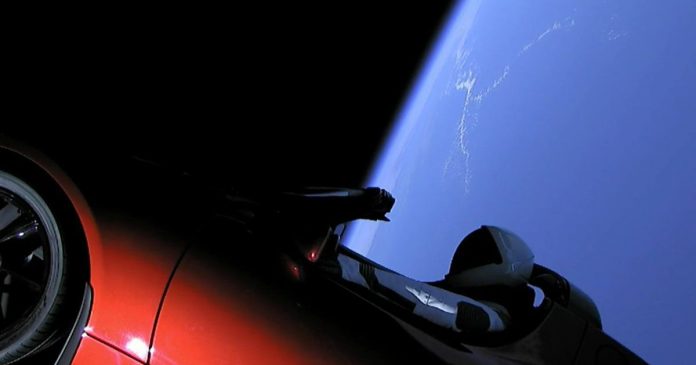There is now a car in orbit around the sun. Welcome to 2018.
The car hitched a ride to space on what is now the most powerful rocket in operation, the Falcon Heavy, built by Elon Musk’s company SpaceX. The goal of the Falcon Heavy’s first flight—aside from not blowing up—was to put the Tesla into an elliptical orbit between Earth and Mars, a car and two planets joined together in an endless loop around the sun. That kind of orbit would, at certain times, bring the Tesla near Mars.
The Tesla successfully reached orbit Tuesday afternoon, attached to the upper part of the rocket, and coasted for about six hours—a move meant to demonstrate a new capability for the U.S. Air Force, one of SpaceX’s customers. A livestream from the payload showed surreal views of the car and its sole passenger, a mannequin stuffed into a SpaceX space suit, floating above Earth. Then SpaceX cut the feed, and the upper stage’s engine reignited one last time to give the Tesla a final push into its destined orbit.
After that final blast, Musk shared the Tesla’s location. The car was heading to the asteroid belt.
The graphic above indicates that SpaceX has calculated the payload’s orbit, and it turns out that the final engine blast propelled the Tesla farther than expected. The push, the pictured orbit seemed to suggest, caused the car to overshoot its final destination and sent it barreling toward the asteroid belt between the orbits of Mars and Jupiter, a ring of small rocks and dust. The largest object in the asteroid belt is a dwarf planet called Ceres.
Astronomers jumped into action, trying to make sense of it all and talking it out together on social media. The numbers provided, they quickly realized, didn’t exactly match up with the orbit pictured.
“We collectively assumed that the numbers on Musk’s tweet were based on telemetry, and that they’d know best,” says Andy Rivkin, a planetary astronomer at Johns Hopkins Applied Physics Laboratory who studies asteroids.
Jonathan McDowell, an astronomer at the Harvard-Smithsonian Center for Astrophysics who has been live-tweeting his attempts to discern the correct orbit, tweeted Wednesday, “Elon is still talking about the Starman going to the asteroid belt,” referring to the nickname Musk gave the dummy driver in a nod to David Bowie. “But I’m not convinced yet …”
Musk’s plot provides numbers for two kinds of points in the orbit of the Tesla: aphelion, the car’s farthest distance from the sun, and perihelion, its closest distance to the sun. Astronomers like Rivkin, McDowell, and others (and probably anyone else less afraid of math than I am) take the average of these two figures and use that to calculate the orbit period of the Tesla.
But because the numbers here seemed off, Rivkin says he and others turned to independent observations made by Rob McNaught, an Australian asteroid observer, which were posted online. Late Wednesday night, their suspicions were confirmed. Revised orbital data provided by SpaceX and shared with nasa’s Jet Propulsion Laboratory’s system for tracking solar-system bodies showed the original graphic was incorrect.















